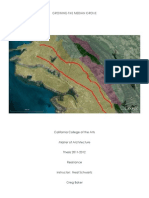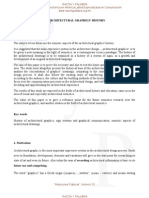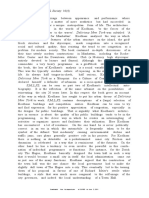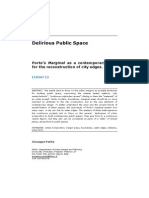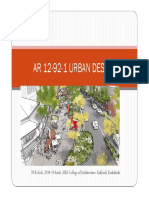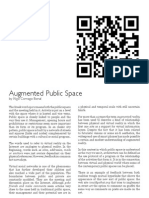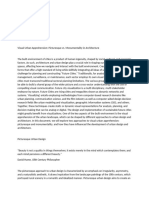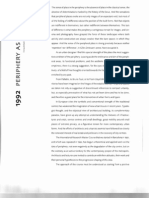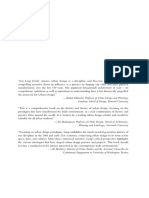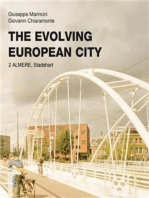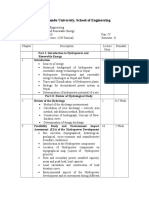Ciudad Moderna Articulo
Ciudad Moderna Articulo
Uploaded by
ajguerrero81Copyright:
Available Formats
Ciudad Moderna Articulo
Ciudad Moderna Articulo
Uploaded by
ajguerrero81Copyright
Available Formats
Share this document
Did you find this document useful?
Is this content inappropriate?
Copyright:
Available Formats
Ciudad Moderna Articulo
Ciudad Moderna Articulo
Uploaded by
ajguerrero81Copyright:
Available Formats
o o o o o o o o o o o o o o o o o o o o o o o o o o o o o o
nicio Secciones Academia Ambiente Arquitectos Arte Bienales Ciudad Concursos Congresos Diseo Diseo Universal Estudiantes Exposiciones Gremios Iluminacin Paisajismo Patrimonio Postgrados Productos Proyectos Publicaciones RSE Tecnologa Tesis de Grado Transporte Da del Arquitecto entre rayas Pautas editoriales Perfil de la revista Poltica editorial Programacin 2011 Programacin 2012 Programacin 2013 EntreSpacio Puntos de Venta Suscripcin Contctenos
Symbolisms in the cities today Skyscrapers
15 sep 2013 | 0
Isabel Barbosa / November 28th 2012 Introduction Broad Concern When we talk about symbolism, we refer to the use of symbols to represent ideas or meanings. Symbolism in architecture refers to the expression of an architectural design, representing a specific place and time, and giving a character that personifies uniqueness. Likewise, when we talk about symbolic architecture, we refer to architectural work that expresses embodied concepts. For example, the pyramids of Egypt, after centuries, still stand and represent the cult of life after death. On the other hand, in The Strip in Las Vegas, architecture and the way it was perceived has completely changed. After many decades, The Strip still represents the idea of signs, lighting, styles, monumentality, symbols, advertising and communication, within our urban realm; as Venturi referred in his book Learning From Las Vegas, The architecture of persuasion. He talks about the role that signs play in conveying, and providing order to the landscape, and he refers to it as a new form of conceiving urban planning; defining a new type of urban sprawl such as symbol in space before form. Las Vegas also defined a new architecture, architecture of communication over space, where communication dominates space as an element in architecture. A communication also present in the new scale of landscape of large spaces and high speeds, when we talk about high speed, we refer to the inclusion of the automobile in the design. When we talk about Las Vegas, we talk about the greatest expression of urban and architectural symbolism, and vernacular architecture. La arquitectura es el testigo menos sobornable de la historia. Octavio Paz (The architecture is the less bribable witness of history) It is clear that Las Vegas has changed the way of perceiving the general concepts of architecture and urban planning for designers. Architecture and urban planning were designed for human scale. In The Strip, we can find commercial architecture at the scale of the Highway and the inclusion of the parking lot. The sign for the Motel Monticello, a silhouette of an enormous Chippendale highboy, is visible from the highway before the motel itself. This architecture of styles and signs is anti-spatial; it is architecture of communication over space. Communication dominates space as an element in the architecture and in the landscape, but it is now used for a new scale of
landscape. Architects have been bewitched by a single element of the Italian landscape: the piazza. It is traditionally pedestrian-scaled. The commercial persuasion of roadside eclecticism provokes a bold impact within the vast and complex setting of a new landscape composed of big spaces, high speeds, and complex programs. The message is basely commercial; the context is basically new. Las Vegas, as a communication system, where the graphic sign in space has become the architecture of this landscape, is where symbol dominates space. Architecture is not enough. Because the spatial relationships are made by symbols more than by forms, architecture in this landscape becomes symbol in space rather than form in space. Architecture itself defines very little; the big sign and the little building is the rule on The Strip. When we talk about Las Vegas, we must mention the inclusion of the parking lot. The scales of movement and space of the highway relate to the distances between buildings. Because they are far apart, they can be comprehended at high speeds. Large spaces between buildings are a characteristic of The Strip, and it is made by these parking lots. The casinos themselves are part of the sidewalk. In The Strip, public space goes right through the casinos and into the inside, where the relation between public open space and private suites is mediated by a set of sensitive devices. The parking lots, which in other cities have about the same public significance as bathroom corridors (they are public, but one would rather not notice them), are here ritualized and given a ceremonial function. When one sees Las Vegas, it is an expression of what was happening in the world, and in the architectural field, 40 years ago. Nowadays, it is a versatile architecture in which the architect does what the client wants. There is no specific style or concept; architecture and the way it is seen goes as far as technology allows it. We talk everyday about green architecture, selfsustainable architecture, monumentality, deconstructivism and high tech. But, what about symbolism in urban design and architecture today? The Strip in Las Vegas is a symbol of power and entertainment. The city serves as a good paradigm for a postmodern city, whose tendencies are intensified to the limit and provide an effective metaphor for the contemporary boom of casino capitalism, so bright, loud, and massive as the game rooms that are located within the lobbies of the hotels which serve as the illusion of freedom within this city of neon lights. The casinos in The Strip are fighting to catch the attention of every tourist, trying to sell the best lifetime experience within their facilities. Whereas, nowadays, the type of architecture that is doing this is the design and construction of skyscrapers, where the companies are trying to sell a lifestyle, competing to have the most technological building; the tallest. Companies are trying to sell themselves through these buildings, to catch the attention of the people in the city and the attention of the entire world. Las Vegas has become one of the main centers of power in the United States. The skyscrapers like The Strip in Las Vegas are a representation of power and marketing of the 21st century. This fact raises the following question: can we consider the skyscrapers, the city skyline, as a representation of power, as expressions of symbolism in architecture today? Is there something, or a specific design type, that is changing the way to interpret architecture today as Las Vegas did 40 years ago, through its symbolism? Or does Las Vegas still have relevance in architectural and visual culture? Can we talk about urban symbolism through specific elements within a city that are able to represent its entire urban character? The first part of this essay is a description of the meaning of symbolism, the role of symbolism in architecture and in urban design, using Learning from Las Vegas as the example of the topic. We will talk about the symbolism of architectural form. The second part will be focused on symbolism today, by studying the skyscrapers as a definition of an element of technology and power. What is the impact of the skyscraper in the city? How does it affect the skyline of a city through its economy impact and how does it change the way the city is perceived by its inhabitants? Symbolism We can talk about symbolism as the art or practice of using symbols, especially by investing things with a symbolic meaning or by expressing the invisible, or intangible, by means of visible or sensuous representations. We can also define symbolism as an invention that is a method of revealing or suggesting immaterial, ideal, or otherwise intangible truths or states. When we refer to symbolic architecture, we use it to describe architecture with a strong degree of personification or with allusions to cultural ideas, historical references, and other pre-Modernist themes. Symbolism in architecture refers to the expression of an architectural design, representing a specific place and time, and giving a character that personifies what makes it unique.
One of the most successful books about symbolism is Robert Venturi, Learning From Las Vegas. With this book, we learned from Las Vegas the power of signage through Robert Venturi and Denise Scott Browns use of the duck and decorated shed, as metaphors for expressive and symbolic architecture. Venturi and Scott Brown acknowledged the duality of architecture: its role as both shelter in its interiority and signage in its communicative, decorative, informative, and symbolic aspects. As Venturi referred in his book, when we talk about Las Vegas we talk about the greatest expression of urban and architectural symbolism, and vernacular architecture. That is why this city is such an important case study when we refer to symbolism in architecture. Even though Las Vegas has symbolized the same concept for the past 30 or 40 years, The Strip still represents the idea of signs, lighting, styles, monumentality, symbols, advertising and communication within our urban realm. As Venturi said, the architecture of persuasion. Is the role that signs play in conveying, and providing order to the landscape, as a new form of conceiving urban planning and defining a new type of urban sprawl; such as symbol in space before form. It is an expression of progress, and technology. When you see Las Vegas, you can only think about a unique experience, a unique architecture, a unique city. It is the pure concept of symbolism. The New Yorkers Paul Goldberger, Pulitzer Prize-winning architecture critic and writer for The New Yorker, said in his interview with the National Building Museum that no other city is precisely like Las Vegas; but neither are other cities as different as they sometimes think they are. The Strip is a wildly exaggerated version of the commercial strip located outside of many cities, and the problems Las Vegas has had with its own commercial Strip are similar to many other cities. I cannot agree more with this statement. In The Strip, we can study how architecture changed from the normal convention forms. What was important 30 years ago? What is Las Vegas trying to tell us? What was the special concern that society had at this time? We see signs, lighting, styles, monumentality, and symbols everywhere. Designing a beautiful building is not important anymore. It is all about advertising and communication, creating architecture of mixed media. Nowadays, we dont speak about symbolism in architecture because we lost the sense for it. When we think about symbolism today, we talk about a void or empty space; we cannot talk about symbolism anymore in the way we talk about symbolism in Las Vegas. Today, symbolism is a versatile architecture in which the architect does what the client wants. As was mentioned before, there is no specific style or concept; architecture and the way it is seen goes as far as technology allows it. We can talk about a deep relationship between architecture and technology, but we cannot analyze symbolism in architecture today without looking at buildings and cities through a technological eye. There is not a specific type of architecture that we can recognize from 40 years from now and say This is the architecture of this period of time. Even though we can find a lot of different types of architecture, such as green architecture, self-sustainable architecture, monumentality, deconstructivism and high tech, today architectural design goes hand-in-hand with technology and this is without any doubts the most important and relevant aspect of architecture in the 21th era. Although today there doesnt exist a specific type of architecture, an urban phenomenon is happening through a special type of building, or perhaps an architectural style, the skyscrapers. Even though the skyscraper is a type of building that can also be symbolic and have its own language, it is not a representation of a vernacular architecture. The style of design of the skyscrapers makes it look like they dont belong anywhere, but that design itself is what allows then to fit everywhere. When we refer to skyscrapers, we are talking about symbols of economic and technological power of cities. The skyscraper began as a type of construction for offices in Chicago in the 19th century and today, is the new representation of a temple dedicated to the economy and to the world business. We can find skyscrapers in the best cities of the world as a symbol of their modernism and power; for example, New York City, Chicago, Shanghai, Hong Kong, Dubai, Beijing, London, Paris, Buenos Aires, Panama and Montevideo, among others. In all these cities, skyscrapers are buildings dedicated to an economy which competes and seeks to excel other economies; both through height and symbolism. But if these buildings are symbols of economic power, they are also symbols of technological power, demonstrated in the aesthetics of the buildings. Some of the buildings look like spaceships, others are very futuristic in designs, but it is the cult of technology, which results in these buildings being energy generators, as well as compensation mechanisms to prevent earthquakes and other natural phenomena.
The relationship between architecture and power is ancient, from ancient Egypt to today. Maybe even necessary. The most powerful men have always inspired the architects. The architecture has constantly been under the power of suggestion. In the building, the triumph over gravity, the authority or power must be made visible. The contemporary incarnation of this phenomenon is the skyscraper, linked to corporations and oil fortunes lately thanks to steel, and especially to the invention and development of the elevator, could overcome the limits imposed other materials and the ability of our legs climbing stairs. As an example of this technological type of architectural design, we can analyze the Bionic Towerdesigned in Shanghai, by linking architecture, to engineering and biology, this skyscraper has a floating foundation with an inner structure that mimics the internal shape of trees.
Another important feature in the symbolism of the skyscraper is the religious feelings and the search for transcendence it evokes. The first buildings in American culture sought to reach the sky and go away from the earth. Initially, the top offices were on the first floor, but with the arrival of the elevator there moved to the upper floors; showing hierarchy, as well as a greater concern towards seeking personal salvation in the highest spots, disassociating man from the problems of the earth and, in many cases, culminating with the company name on top of the building or trademarks signs. The skyscraper also represents the evolution of capitalism. The change from a productive economy, a sober and rational capitalism, into a more theatrical capitalism, based on consumption, irrationalism, and individualism. Today, the economic growth of a country is reflected in its monumental buildings; the higher the better. This is a trend that has been happening continuously for the past 20 years. Until the beginnings of the 20th century, the tallest building was the Eiffel Tower, standing at 300 meters; but in the last ten years, we have tripled that height, with buildings that are projected to reach more than 800 meters high. The symbolism of economy and power, evident in the skyscrapers of a city, is clearly manifested when we analyze the fact that the two countries with the highest number of skyscrapers are the U.S., with more than 16,000, and China, which is over 8,000. While earlier tall buildings were built intended for office use, skyscrapers today are also entertainment centers, theaters and hotels; thus, vertical cities. There is a direct relationship between the symbolism in The Strip in Las Vegas and skyscrapers today. Both are examples of power, mixed media, advertising, and the marketing weapon. There is no doubt that the skyscraper is an icon of the modern city, the city overfilled; sometimes its the solution; in other cases, is the cause. However, we are talking about symbolism as a whole. We are talking about the impact that skyscrapers have in the cities in which they are. What happens to the countries or cities without these modern icons? That said, the issue is whether contemporary cities can bequeath other icons, or other types of symbolic architecture. Paris, for example, has managed well the fact that a palace, such as the Louvre museum, still remains an iconic piece of architecture within the city, even with the modern, transparent pyramid that distinguishes it today. A symbol of power that is reflected in a very pure an elegant solution, without the necessity of reaching up towards to the sky. In the case of existing constructions, we can mention the Guggenheim Museum in Bilbao, Spain. In Manhattan, for example, is justified the construction of tall buildings, because there is a high activity and a limited ground which can be filled. In cities such as Caracas, however, the most important design factor is its topography and therefore any iconic work has to do with it. Such matters are what will distinguish them from other cities, because the rest are international solutions that do not show character. This kind of international solutions seems to be the skyscrapers in these days. The skyscrapers, as icons of power, have brought into place one of the most impacting catastrophes of the last 20 years. New York was the scene of a major terrorist attack that turned the course of contemporary history. A suicide group of young Islamic militants led by Mohamed Atta, architect and urban planner, knocked two skyscraper towers, located in Manhattan, designed by Japanese-American architect Minoru Yamasaki. These skyscrapers symbolized the citys financial power and global leadership of the United States. This atrocious action caused an unprecedented geopolitical crisis, putting into question the future of skyscrapers. However, the predicted decline of skyscrapers, -due to their complexity, high costs, and now extreme vulnerability is a concept that couldnt be farther away from reality. With a revised security, and the inevitable increase of budgets, the protagonists of public, and private, power and economy, have been building skyscrapers to show their constant competition along the skies. Although beyond the 200 meters high, towers dont have economic justification, the continued competition between cities and countries for power, gain everyday media attention and arouse the curiosity of the people. The city of New York, which suffered that devastating attack on September 11 2001, does not resign itself to being known as The Big Apple, and continues to build and propose new towers, often linked with persistent cultural and artistic leaderships, such as the Hearst newspaper group and The New York Times headquarters (designed by Norman Foster and Renzo Piano); the small stack of New Museum (designed by the Japanese Sejima and Nishizawa) or the residential skyscraper designed by Frenchman Jean Nouvel next to the MOMA. The importance of skyscrapers today as symbolism of architecture and power is so real, that there is an international phenomenon that is happening where small countries, or cities, that do not
belong to the first world, have adopted solutions like building skyscrapers to encourage the country to provide a technological image of the city without taking into account the real situation in which the city and the people live. Today, it is so important to have skyscrapers in cities so that they can appear on the world map; but in some cases, skyscrapers are introduced in society as an alternative and strange entity, that ultimately becomes an obstacle along the urban level, hurting the city rather than helping it to progress. We can take the example of La Torre David, in Caracas, Venezuela, in order to prove this point. A skyscraper designed to impulse the economy of the city. La Torre David wanted to provide a technological image of the private company sector, to show the world that Caracas was able to have big tall buildings. La Torre David is nowadays an abandoned and unfinished office building in Caracas. Standing at 45 stories, the concrete frame structure designed by Venezuelan architect Enrique Gomez, was almost finished when the project was left in its incomplete form following the death of its developer in 1993; and the collapse of the South American countrys economy in 1994. Today, the tower functions as an improvised home for more than 750 families, inhabited by people whom would otherwise livewithin the barrios of the city; and has become a functioning and independent living environment for residents through a random and organic method of development. Some have even called the extra-legal, and tenuous occupation, a vertical slum. This is one of the clearest examples of how wrong it is to force a city that is not ready for a skyscraper, with the only purpose of putting the city in the spotlight. When the modern city does not adapt to the people, the people will adapt to the city.
The skyscrapers, high-rise buildings, are the ultimate symbol of twentieth century architecture. They not only have an economic function, to maximize the price of land, but they also have a symbolic function. As the buildings grow they are changing their concept and function; and they are not just part of the city, but small cities in themselves. For example, the Twin Towers in New York had their own zip code; with streets, squares, shopping centers and entertainment centers. The bases of these skyscrapers are authentic, large public squares. They distribute the flow of people entering the building, through stairs and elevators. Not only they are built homes, but offices and public schools, as well.
As we said before, there is no doubt that the skyscraper is an icon of the modern city, an icon of power, technology, economy, and marketing. The effect of skyscrapers in cities is undeniable, representing, globally, the way people feel when living in a city of skyscrapers. As the buildings in The Strip in Las Vegas, the skyscrapers are the perfect example of symbolism these days. They represent the era that we are living in. Skyscrapers are the symbol of big cities; nevertheless, they are not the symbol of the modern cities. As was mentioned before, we must distinguish between what is modernism, and what satisfies personal egos. The modern city is not the city that has more skyscrapers, but the most friendly and sustainable, which is more in line with what society really needs: parks, spaces, satisfaction and quality of life. A city made for people, not to satisfy the ambitions of companies. But, this is the world in which we are living in, where there is an ongoing competition about what city has the tallest building, which company owns it and what architect designed it. Nobody wants to be left behind in this process of technological image. This is the great legacy that we are leaving to our successors to study 40 years from now. Everyone wants to be a part of the history and symbolism of architecture today. Isabel Kristina Barbosa Aguilar ikba1705@gmail.com Venezuelan Licensed Architect NATIONAL ARCHITECTURAL AWARD VENEZUELA, 2010 / SALON MALAUSENA Education SCHOOL OF THE ART INSTITUTE OF CHICAGO. CHICAGO IL. USA / MASTER OF ARCHITECTURE WITH EMPHASIS IN INTERIOR ARCHITECTURE. 2014 UNIVERSIDAD EXPERIMENTAL SIMON BOLIVAR CARACAS. VENEZUELA / BACHELOR IN ARCHITECTURE. 2009 Professional Experience SKIDMORE. OWINGS & MERRILL MAY 2013 PRESENT Chicago IL USA Part of a teamwork developing a variety of projects at different scales. Residential projects in a mix uses skyscraper. International architectural competition, corporate projects and more detail orientated projects AIL ARQUITECTOS C.A. MAY 2010 _ SEPT 2011 Caracas. Venezuela Acted as primary point of contact for clients on a variety of projects such as residential. interior design commercial and office design resort projects in Dominican Republic and throughout Venezuela. designed in a team work. Conducted client meetings: prepared presentation drawings construction documents. and specifications with special emphasis in interior design details. furniture design and site inspection. OAMCD ARQUITECTURA OCT 2009 MAY 2010 Caracas. Venezuela Developed a varietld of projects such as residential (Beach House]. Urban planning Metropolitan plan for potencial use of water resources from Avila National Park. national architectural contest and international architectural contest.
You might also like
- API 650 - Cone Roof Tank AnalysisDocument44 pagesAPI 650 - Cone Roof Tank AnalysisKautilya SharmaNo ratings yet
- Parallel Cities. The Multilevel Metropolis. Capítulo 05. TheDocument31 pagesParallel Cities. The Multilevel Metropolis. Capítulo 05. TheLAYLA JORQUERA SEPULVEDANo ratings yet
- Sola-Morales 2004 Cities & Urban CornersDocument4 pagesSola-Morales 2004 Cities & Urban CornersNeil SimpsonNo ratings yet
- Shaping The City Studies in History, Theory and Urban Design (Rodolphe El-Khoury, Edwards Robbins)Document441 pagesShaping The City Studies in History, Theory and Urban Design (Rodolphe El-Khoury, Edwards Robbins)Samara Gusman100% (1)
- Planning The Ideal CityDocument11 pagesPlanning The Ideal CityGianluca SpinatoNo ratings yet
- Imaging the City: Art, Creative Practices and Media SpeculationsFrom EverandImaging the City: Art, Creative Practices and Media SpeculationsNo ratings yet
- NCR 6632 Site PreparationDocument38 pagesNCR 6632 Site PreparationDamian RamirezNo ratings yet
- Radha Sahdev - Reading Response - Five Open FormsDocument6 pagesRadha Sahdev - Reading Response - Five Open FormsRadha SahdevNo ratings yet
- Learning From Las VegasDocument3 pagesLearning From Las VegasMario Postigo HernándezNo ratings yet
- Growing The Median GroveDocument11 pagesGrowing The Median GroveGreg BakerNo ratings yet
- Semiotic Aspects of Architectural Graphics' HistoryDocument15 pagesSemiotic Aspects of Architectural Graphics' HistoryAndreea AlecsandruNo ratings yet
- Adam 2Document1 pageAdam 2api-291990968No ratings yet
- Introduction To Urban Design TheoriesDocument6 pagesIntroduction To Urban Design Theoriesحسام ساجت عويدNo ratings yet
- Unorthodox Ways To Think The City: Teresa StoppaniDocument6 pagesUnorthodox Ways To Think The City: Teresa StoppaniAneta Mudronja PletenacNo ratings yet
- Aldo Rossi: Architecture of The CityDocument8 pagesAldo Rossi: Architecture of The CitymahaNo ratings yet
- Important To ReadDocument7 pagesImportant To ReadParul VyasNo ratings yet
- Arc - Urban DesignDocument396 pagesArc - Urban DesignCindy SlrNo ratings yet
- The World in Our Eyes Curatorial StatementDocument4 pagesThe World in Our Eyes Curatorial StatementFabrizio GallantiNo ratings yet
- Noli Me TangereDocument3 pagesNoli Me TangereSam MartinezNo ratings yet
- The Generic City Maarten Hajer PDFDocument7 pagesThe Generic City Maarten Hajer PDFMariana PaesNo ratings yet
- Urban Hibridization TextsDocument20 pagesUrban Hibridization TextsivicanikolicNo ratings yet
- History NotesDocument3 pagesHistory NotesJulia ArkhipovaNo ratings yet
- Wright. Urban Spaces and Cultural SettingsDocument6 pagesWright. Urban Spaces and Cultural SettingsEquinoprietoNo ratings yet
- Zamparini Et Al 2023 Iconic Buildings in The Making of City Identity The Role of Aspirational Identity ArtefactsDocument22 pagesZamparini Et Al 2023 Iconic Buildings in The Making of City Identity The Role of Aspirational Identity ArtefactsAbdullah MalikNo ratings yet
- URBAN DESIGN - Aldo RossiDocument12 pagesURBAN DESIGN - Aldo RossiArjunNo ratings yet
- Delirious Public SpaceDocument12 pagesDelirious Public SpaceLuísNo ratings yet
- Beyond Urban ProjectsDocument4 pagesBeyond Urban ProjectsmarcjurdakNo ratings yet
- Andrea Kahn - Defining Urban Sites PDFDocument16 pagesAndrea Kahn - Defining Urban Sites PDFRomina VillaNo ratings yet
- Ideal Cities by Arch SymbolonDocument2 pagesIdeal Cities by Arch SymbolonF RNo ratings yet
- 1971 Scott Brown - Learning From PopDocument5 pages1971 Scott Brown - Learning From PopYhulianov Hortencia concha ZavaletaNo ratings yet
- Post-It City: The Other European Public Spaces // Giovanni La VarraDocument2 pagesPost-It City: The Other European Public Spaces // Giovanni La VarraGonzalo LuyoNo ratings yet
- Agogic MapsDocument78 pagesAgogic MapsK. Mille100% (1)
- A Contemporary Phenomena Occuring in Many Cities Around The World Is That ofDocument5 pagesA Contemporary Phenomena Occuring in Many Cities Around The World Is That ofHanna WijayaNo ratings yet
- Mapping Urban Experience DigitallyDocument26 pagesMapping Urban Experience DigitallyHasan Basri KartalNo ratings yet
- UD-Module 1Document65 pagesUD-Module 1Varsha biju100% (2)
- Dubai Tourism Case StudyDocument12 pagesDubai Tourism Case StudyJamal PanhwarNo ratings yet
- Augmented Public Space by Iñigo CornagoDocument3 pagesAugmented Public Space by Iñigo CornagoibonalNo ratings yet
- Venturi Learning From Las Vegas PDFDocument25 pagesVenturi Learning From Las Vegas PDFRemus Cristi100% (5)
- 1 s2.0 S1110016823006439 MainDocument14 pages1 s2.0 S1110016823006439 Mainnoaime79No ratings yet
- Designed To Improvethe Makings, Politics and Aesthetics ofDocument11 pagesDesigned To Improvethe Makings, Politics and Aesthetics ofสามชาย ศรีสันต์No ratings yet
- 0201Document25 pages0201mymalvernNo ratings yet
- STUDIO Is A PlatformDocument1 pageSTUDIO Is A PlatformSérgio Padrão FernandesNo ratings yet
- Art Urbanism CritiqueDocument10 pagesArt Urbanism Critiqueana_australianaNo ratings yet
- New Urbanism and Creativity in Individual Architectural ProjectsDocument3 pagesNew Urbanism and Creativity in Individual Architectural ProjectsAnonymous uwoXOvNo ratings yet
- Visual Urban ApprehensionDocument10 pagesVisual Urban ApprehensionYazan AltayNo ratings yet
- Context Form and Character in ArchitectuDocument5 pagesContext Form and Character in ArchitectuLeoCutrixNo ratings yet
- Seaside and The Real World A Debate Onamerican UrbanismDocument2 pagesSeaside and The Real World A Debate Onamerican UrbanismmercedesdellorussoNo ratings yet
- Nidhi0501.20060814.002048 - THE CITY SHAPEDDocument5 pagesNidhi0501.20060814.002048 - THE CITY SHAPEDMonica EnescuNo ratings yet
- I Like Cities Do You Like Letters? Introducing Urban Typography in Art EducationDocument10 pagesI Like Cities Do You Like Letters? Introducing Urban Typography in Art EducationRaquel MoraisNo ratings yet
- De SOLA MORALES, Manuel (1992) - Periphery As ProjectDocument7 pagesDe SOLA MORALES, Manuel (1992) - Periphery As ProjectevelynevhNo ratings yet
- UrbanDocument389 pagesUrbanRod Harrison50% (4)
- The Lost Space of Architecture in The Context of Urban Lost SpaceDocument11 pagesThe Lost Space of Architecture in The Context of Urban Lost SpaceOtilia BarladeanuNo ratings yet
- Preview PDFDocument69 pagesPreview PDFvijimol vijaya kumarNo ratings yet
- Urban PhotographyDocument34 pagesUrban PhotographyCollect ArtNo ratings yet
- Dream Cities: Seven Urban Ideas That Shape the WorldFrom EverandDream Cities: Seven Urban Ideas That Shape the WorldRating: 3.5 out of 5 stars3.5/5 (9)
- The Evolving European City - Introduction: 1 IntroductionFrom EverandThe Evolving European City - Introduction: 1 IntroductionNo ratings yet
- City Lights and Urban Delights: Exploring Metropolitan WondersFrom EverandCity Lights and Urban Delights: Exploring Metropolitan WondersNo ratings yet
- Determinacion de Aromaticos ASTM D5186Document8 pagesDeterminacion de Aromaticos ASTM D5186Carlos GonzalesNo ratings yet
- SFPE Handbook of Fire Protection Engineering: Torero, J.M. Watts JR., C.J. Wieczorek (Eds.)Document1 pageSFPE Handbook of Fire Protection Engineering: Torero, J.M. Watts JR., C.J. Wieczorek (Eds.)Paraschiv AlexandruNo ratings yet
- Beware These Tricks For Making You Look Bad in Meetings - Gretchen Rubin - LinkedInDocument16 pagesBeware These Tricks For Making You Look Bad in Meetings - Gretchen Rubin - LinkedInbabba123No ratings yet
- Course Syllabus of Hydropower and Renewal EnergyDocument3 pagesCourse Syllabus of Hydropower and Renewal Energydrbhatta100% (1)
- Cup SealerDocument16 pagesCup SealerFaitur SamboNo ratings yet
- Cycle Time Reduction in Injection Molding ProcessDocument9 pagesCycle Time Reduction in Injection Molding ProcessPFE100% (1)
- Catalog Grote Section 14 Mounting OptionsDocument20 pagesCatalog Grote Section 14 Mounting OptionsBillNo ratings yet
- Lc430duy-Sha1-Lg 125 212 PDFDocument37 pagesLc430duy-Sha1-Lg 125 212 PDFFabio A'lgarinNo ratings yet
- 1 PBDocument12 pages1 PBSyahril Efendy0% (1)
- Dynapac CP 274 PDFDocument1 pageDynapac CP 274 PDFGustavo FajardoNo ratings yet
- SCI Rotary Compressor PDFDocument13 pagesSCI Rotary Compressor PDFcalvin.bloodaxe4478100% (2)
- Type 994 - 0001 Water Bath Desuperheater: For Desuperheating Superheated Steam To Saturated Steam TemperatureDocument4 pagesType 994 - 0001 Water Bath Desuperheater: For Desuperheating Superheated Steam To Saturated Steam Temperaturemn_sundaraamNo ratings yet
- Debug LogDocument344 pagesDebug Logfsfssfshgf562No ratings yet
- 10-02-2020 - Handwritten Notes @job9.inDocument20 pages10-02-2020 - Handwritten Notes @job9.inasudar100% (1)
- Application Guide For TRV For High-Voltage Circuit Breakers PDFDocument39 pagesApplication Guide For TRV For High-Voltage Circuit Breakers PDFsorry2qazNo ratings yet
- Receiver DVB-S2 HDTV Miniatur Laporan UjiDocument7 pagesReceiver DVB-S2 HDTV Miniatur Laporan UjiAlexander WieseNo ratings yet
- Losses of Prestress: Elastic Shortening, Friction, Anchorage Slip, Creep, Shrinkage, RelaxationDocument29 pagesLosses of Prestress: Elastic Shortening, Friction, Anchorage Slip, Creep, Shrinkage, RelaxationLalitha Krishna MoorthyNo ratings yet
- MC 68230Document74 pagesMC 68230Osama OmranNo ratings yet
- Camel Audio FAQs PDFDocument14 pagesCamel Audio FAQs PDFfreimannNo ratings yet
- Storage Volume For Detention Basins: Estimating The Effect of StorageDocument11 pagesStorage Volume For Detention Basins: Estimating The Effect of StorageRufo Daskeo Jr.No ratings yet
- Jar Doc 06 Jarus Sora v2.0Document30 pagesJar Doc 06 Jarus Sora v2.0Juan Moya100% (1)
- Berryman 1999Document3 pagesBerryman 1999Falza WihdanyNo ratings yet
- Fir and I I R Filters Worksheet AnswersDocument9 pagesFir and I I R Filters Worksheet AnswersNoedjoem Kaboer AerNo ratings yet
- Firt Floor Plan A1 PDFDocument1 pageFirt Floor Plan A1 PDFanzaniNo ratings yet
- Jay Holland DetailedDocument5 pagesJay Holland DetailedJay NovaNo ratings yet
- Approval and Declaration SheetDocument6 pagesApproval and Declaration SheetAmer AQmiNo ratings yet
- Effect of Types of Aggregate and Sand-To-Aggregate Volume Ratio On UPVDocument11 pagesEffect of Types of Aggregate and Sand-To-Aggregate Volume Ratio On UPVAmry DasarNo ratings yet
- Coastal Process StructureDocument49 pagesCoastal Process Structureshakirhamid6687No ratings yet










